Basketball Offense - Spread Delay Offense
By Dr. James Gels, From the Coach’s Clipboard Basketball Playbook"Helping coaches coach better..."
Sometimes you need an offense to slow things down, to delay and control the tempo, or to run the clock out at the end of a half or the end of the game (when you have the lead). When running this offense, have your best ball-handlers and free-throw shooters in the game - the defense will often foul to stop the clock.
A coach might use this "spread-delay offense" if there is no shot clock and if he/she believes his team is strongly out-matched. Several years ago, we had a very strong team (scoring about 80/game), and an opposing coach ran this offense against us the entire first half, with a resulting half-time score of 12-8! - (boys high school varsity).
To run this offense, you have to sell it to your players. Kids like to score points, and there won't be many scored with this offense. The fans won't like it either, and expect "boos"! But the idea is to win the game, and this offense could help you get an upset win.
Even teams that like to run and play up-tempo could find this offense useful at the end of the game, in running out the clock, or for the last shot of a period. The goal is to control tempo and clock, and score with lay-ups and free-throws. Even though we are delaying, we still look to score lay-ups off back-cuts and dribble-penetration.
"Spread" Offense Pattern
This is a patterned 5-out, open-post offense (diagram A). The opposite wing O3 cuts to the lane-line and then makes are hard cut up top to get the pass from O1. O1 cuts through (and could get the pass back for a lay-up) and goes to the opposite corner. O5 rotates up to the wing. Then O2 cuts to the lane-line and makes the hard cut up top for the pass from O3 (diagram B). O3 cuts through to the opposite corner, as O4 rotates to the wing. Are you beginning to see the pattern here?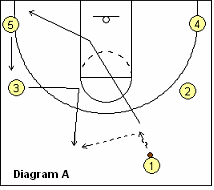
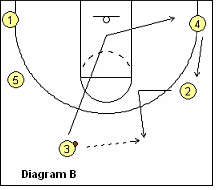
In diagram C, O5 makes the next "L-cut" to the top, and gets the pass from O2. O2 cuts through to the corner and O1 rotates up to the wing. In diagram D, O4 L-cuts to the top and gets the pass from O5, and O5 cuts through. Notice in diagram D that anytime a post player (or someone with a size advantage over a defender) cuts through, he could quickly "come back" to the ball in the paint and post-up for a quick pass inside. If the pass is not there, O5 then moves out to the corner, and O3 rotates up to the wing.
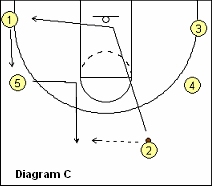
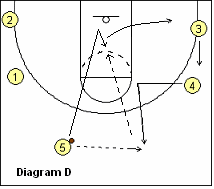
Cutters, Scoring
At all times, we are looking for opportunities to score lay-ups. We are not satisfied in just endlessly running this pattern, but look to score. Defenders will get frustrated and start gambling and over-play cutters - and this is when a back-cut is so effective.Wing Back-Cut
Diagram E shows O1 starting the L-cut, but feels the defender overplaying him (denying the pass, or impeding the cut) - so O1 makes a quick back-cut to the hoop, looking for the pass from O4 and the lay-up.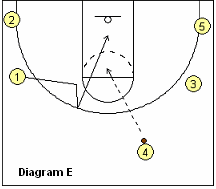
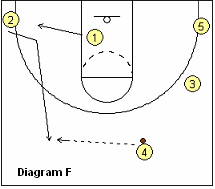
If the pass to the cutter O1 is not there, diagram F shows how to "fix things". O1 moves out to the weak-side corner. As soon as he sees O1 back-cutting, the weak-side corner O2, cuts up top to get the next pass from O4.
Optionally, we can re-create the basic pattern by simply having O4 dribble to the left-side (diagram G). O3 now makes the L-cut and we are back to running our basic pattern - always looking for chances to back-cut and score.
Wing Back-screen
Diagram H shows a continuation of diagram G, where O4 has passed to O3 and has cut through. But this time O4 holds up a fist, indicating to O5 that he will back-screen for O5. O5 starts his usual movement up toward the wing, and then suddenly back-cuts around O4's screen for a pass and lay-up. After screening, O4 fills the wing and O5 moves out to the corner if he does not receive the pass inside.Diagram I shows we are right back in the basic pattern, with O2 now L-cutting up top for the pass from O3.
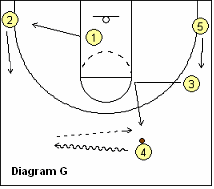
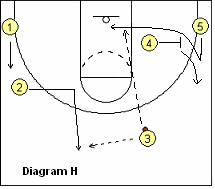
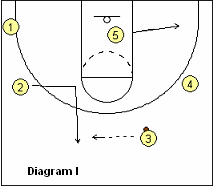
Corner Back-Cut
Diagram J shows how the ball-side corner-wing player at any time could back-cut, without a back-screen. If O1 senses an overplay by his defender, O1 quickly back-cuts for a pass and lay-up. If the pass is not there, O2 passes to O4 L-cutting to the top, and O2 cuts through but this time fills the same-side corner (diagram K). O3 cuts up to top as soon as he sees the wing back-cut.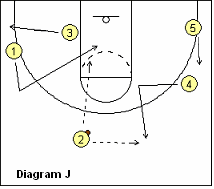
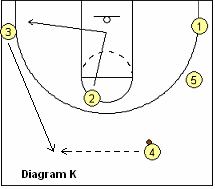
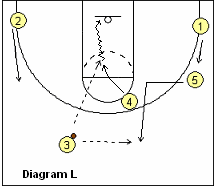
Give and Go Pass
Lastly, diagram L shows that at any time, we could pass to the top cutter for a "give and go" and a lay-up. Here O4 has passed to O3 on top. O4 cuts through and gets the pass from O3 for the lay-up. If the pass is not open, O4 goes to the left corner, as O5 makes the L-cut for the next pass.Dribble-Penetration
This delay offense is mostly a passing, cutting, and spacing offense. However, a player with the ball at the top could take his defender 1-on-1 with the dribble... (more in the members section).Variation: 3-Guard Pattern
Here's an optional way of running the basic pattern. You might not want your "bigs" (O4 and O5) handling the ball... (more in the members section).See the complete article in the members section.
Sign up now!
The complete article also includes:
- dribble-penetration options
- 3-guard pattern
- And a detailed Animation!
In summary, this spread offense often frustrates better opponents, causing them to gamble and over-play on defense, resulting in chances for easy lay-ups. You can control tempo and keep the score low. Players must be disciplined, good ball-handlers and good free-throw shooters. They must realize, that late in a game when you are trying to "kill the clock", the 3-point shot is not an option - only lay-ups and free-throws. However, even when trying to run out the clock, still look to score an uncontested lay-up, as that is an easier shot than pressure-packed free-throws. And sometimes that last basket can "seal the deal".
If you play without a shot clock, this offense might help you get an upset victory - but you must get off to a good start. Once you get behind, you'll have to abandon this offense.
Related pages: